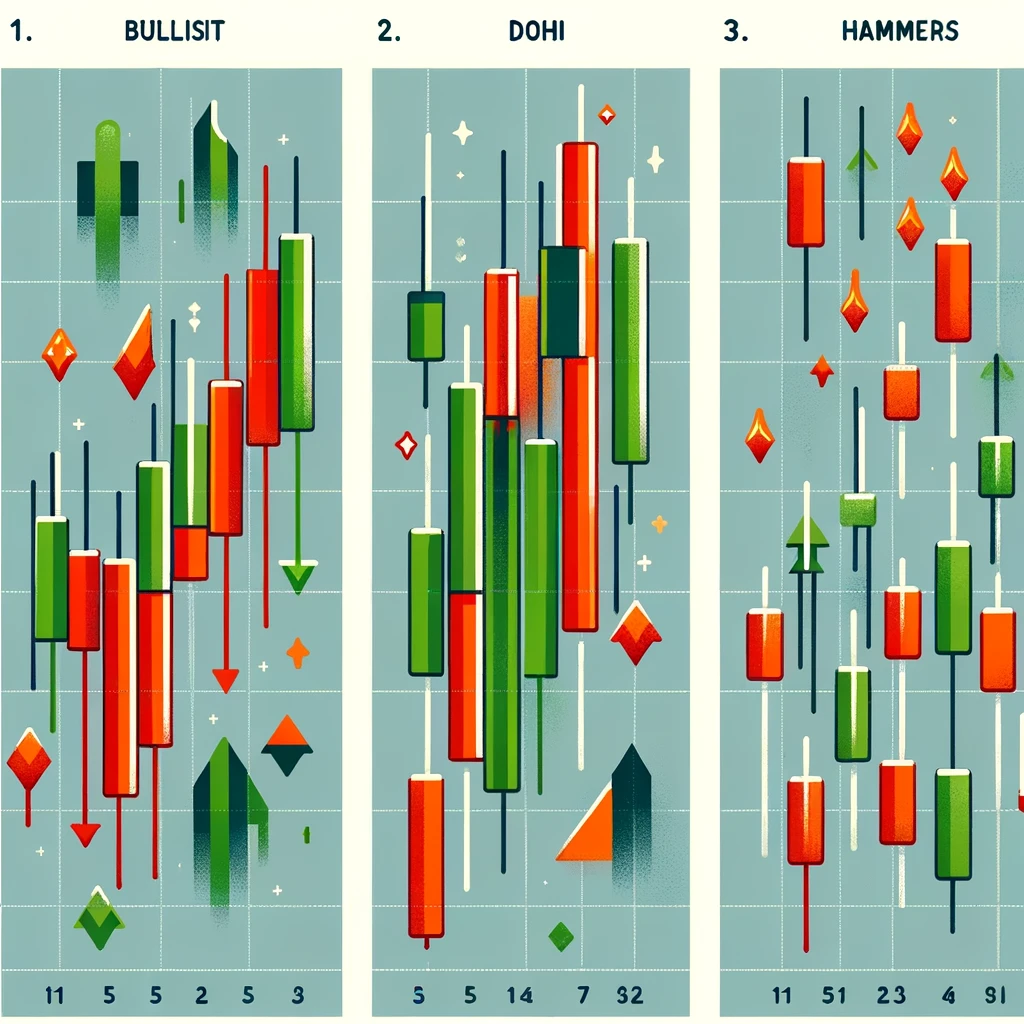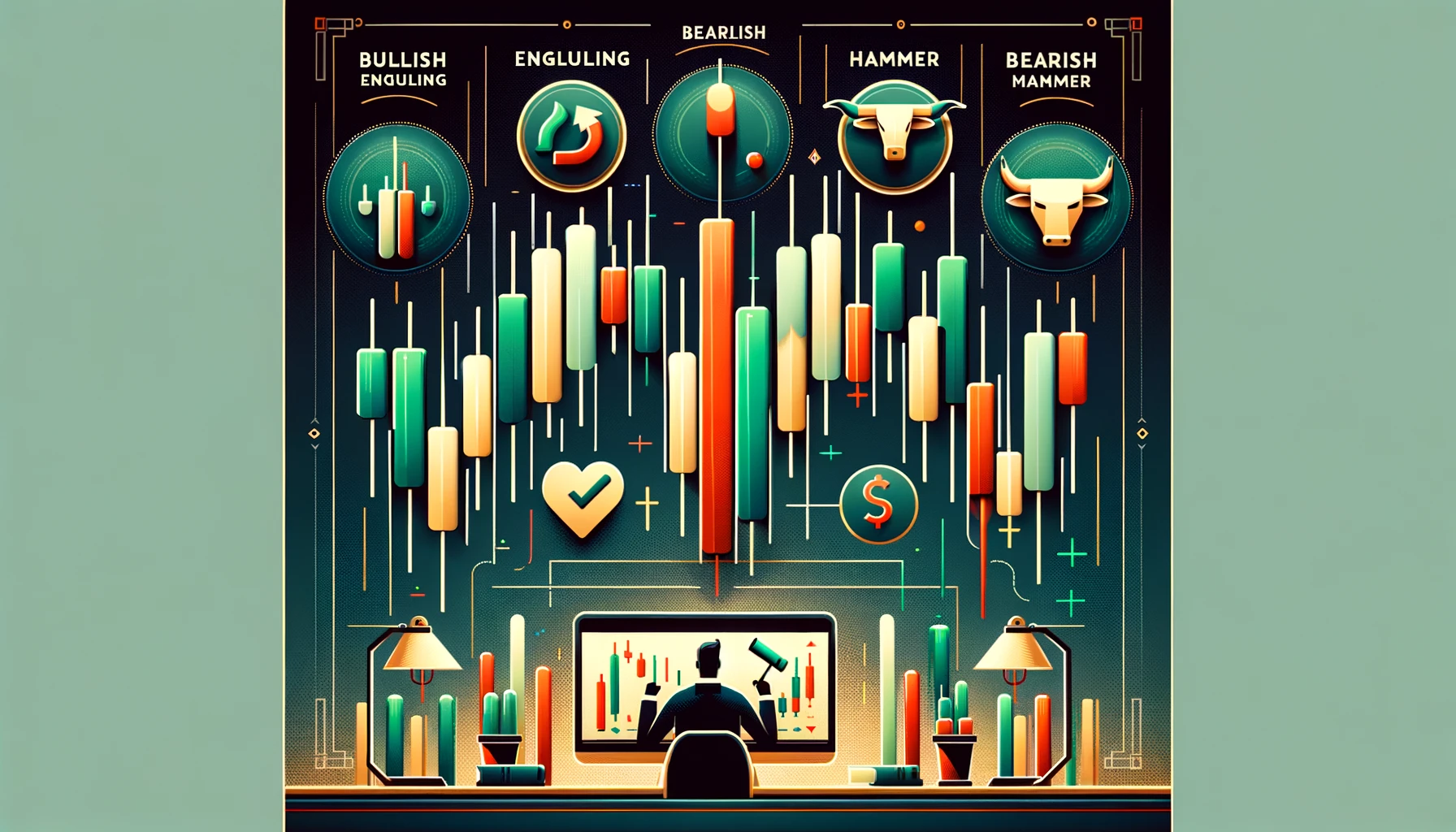Page Contents
Candlestick charts, originating from ancient Japanese commodity trading, have become a pivotal tool in modern financial analysis.
These charts offer a deeper insight into market dynamics, providing more than just price movements but the psychology behind them.

Warren Buffett’s adage,
“The stock market is designed to transfer money from the Active to the Patient,”
highlights the importance of informed decision-making, where candlestick charts play a crucial role.
In this article, you will learn:
- The intriguing history of candlestick charts
- How to decode key candlestick patterns through detailed examples
- Practical tips to avoid common pitfalls in candlestick analysis
Join us as we delve into the art and science of candlestick charting, uncovering the stories told by each pattern and how they can guide your trading decisions
Historical Background of Candlestick Charts
The art of candlestick charting was not born in the bustling stock exchanges of the world but in the rice markets of 18th century Japan. A legendary rice trader named Munehisa Homma developed these charts to track market conditions and price movements in Ojima, the rice market in the city of Osaka. His pioneering work laid the foundation for what would become a crucial tool in technical analysis.
Homma realized that while the supply and demand of rice controlled prices, the emotions of the traders often influenced these two forces. By recording the opening, closing, high, and low prices each day, he could visualize market sentiment and predict future movements. His methods were so successful that they were kept as a closely guarded secret among Japanese commodity traders for nearly two centuries.
It wasn’t until the late 20th century that candlestick charting crossed Japanese shores, brought to the Western world by Steve Nison through his seminal work, “Japanese Candlestick Charting Techniques.” This introduction marked a turning point as traders around the globe began to embrace these techniques, appreciating their ability to reveal market psychology and aid in decision-making processes.
This journey from ancient Japan to today’s digital trading floors illustrates the timeless value of candlestick charts. They serve not just as a tool for recording prices but as a window into the emotional undercurrent of the markets.
Understanding Candlestick Patterns
Candlestick patterns are the language through which traders can interpret market sentiments. Each pattern, made up of one or several candlesticks, tells a story about the behavior of traders during a given timeframe. To harness the full potential of these patterns, it’s crucial to grasp their basic structure and what they reveal about market dynamics.
Key Candlestick Patterns:
1. Bullish Engulfing Pattern: This occurs when a small bearish candlestick is followed by a large bullish candlestick that completely engulfs the previous day’s body. This pattern indicates a strong shift from sellers to buyers, suggesting a potential upward movement in the price.
2. Bearish Engulfing Pattern: The opposite of the bullish engulfing, this pattern features a small bullish candlestic followed by a large bearish candlestick that engulfs the first. It signals a shift from buyers to sellers, hinting at a possible price decline.

3. Doji: Characterized by its thin body, a Doji candlestick appears when the opening and closing prices are virtually equal. It represents indecision in the market, suggesting that neither buyers nor sellers could gain the upper hand. A Doji after an uptrend may signal a reversal or a pause in the upward movement.
4. Hammer and Hanging Man: The Hammer and Hanging Man patterns both feature a small body with a long lower wick and a short or no upper wick. The Hammer, appearing after a decline, suggests a potential reversal to an uptrend. Conversely, the Hanging Man, appearing at the end of an uptrend, can indicate a forthcoming downtrend.
Each of these patterns provides clues to underlying market sentiments, but their reliability increases when combined with other technical analysis tools. For instance, a bullish engulfing pattern accompanied by high trading volume offers a stronger buy signal than the same pattern with low volume.
Reading Patterns in Context:
To effectively use candlestick patterns, traders must consider the broader market context. A bullish pattern in a predominantly bearish market might not indicate a complete trend reversal but rather a temporary rally. Similarly, patterns should be read in conjunction with price trends, support and resistance levels, and other technical indicators to make informed trading decisions.
By understanding these patterns and their implications, traders can make more nuanced and informed decisions, aligning closely with market dynamics and enhancing their trading strategies.

How to Read Candlestick Charts Effectively
Reading candlestick charts is a skill that combines understanding individual candlesticks with a broader appreciation of market trends and psychological cues. Here’s a step-by-step guide to mastering this essential trading tool:
Step 1: Identify the Basic Elements
Each candlestick provides four key pieces of information: the opening price, the closing price, the highest price, and the lowest price during the timeframe. The body of the candlestic shows the range between the opening and closing prices, while the wicks (or shadows) indicate the high and low prices. A candlestick where the close is higher than the open is typically filled in green or white, signaling buying pressure. Conversely, a candlesticwhere the close is lower than the open is filled in red or black, indicating selling pressure.
Step 2: Look for Patterns
After identifying the basic elements, the next step is to look for patterns over several days. Patterns can reveal the potential future movements in the market. For example, a series of consecutive green candlesticks with increasing lengths suggests a strong uptrend, while a series of red candlesticks might indicate a downtrend.
Step 3: Contextualize with Technical Indicators
Candlestick patterns are more reliable when supported by other technical indicators such as moving averages, Relative Strength Index (RSI), or volume metrics. For instance, a bullish engulfing pattern occurring above a long-term moving average may confirm a strong buy signal, whereas the same pattern below a moving average could be less persuasive.
Step 4: Consider Market Sentiment
Beyond just the patterns and indicators, it’s important to consider overall market sentiment and external factors that could influence price movements, such as economic indicators or significant news events. This holistic approach helps in making more informed decisions.
Step 5: Use Diagrams for Clarity
Visual aids and diagrams can greatly enhance the understanding of candlestick charts. Below are examples of how different patterns can appear in real market scenarios, with annotations explaining each scenario:

- Diagram 1: Bullish Engulfing Pattern at a key support level.
- Diagram 2: Doji at the top of an uptrend, signaling a possible reversal.
- Diagram 3: Series of Hammers indicating a potential bottom in market price.
By following these steps and continuously practicing reading candlestick charts, traders can improve their ability to gauge future market movements and make more informed trading decisions.

Testimonial
“When I started trading, understanding candlestick patterns turned my trading around. It’s not just about the patterns but also the story they tell about market sentiment. Candlestick charts helped me see the market’s psychological dynamics and react before major price changes occurred,” says Alex Johnson, a professional trader.
Applying Candlestick Charts in Trading
Candlestick charts are not merely tools for viewing historical price data; they are instrumental in formulating trading strategies. Here’s how traders can apply the insights gleaned from candlestic charts to enhance their trading decisions:
1. Combining Candlestick Patterns with Trading Strategies
- Trend Following: Use candlestick patterns to confirm the continuation of a trend. For instance, a series of bullish engulfing patterns during an uptrend supports a buy strategy.
- Reversals: Candlestick patterns like the Hammer or the Bearish Engulfing can signal potential reversals. Traders might consider this an opportunity to enter or exit trades based on the reversal signals.
- Breakouts: Candlesticks can help identify consolidation phases which might lead to breakouts. Patterns like the Doji or small bodies with long wicks can indicate a tightening price range, often preceding a significant price movement.
2. Psychological Insights
Candlestick charts reflect the psychological state of the market. Patterns like long lower wicks can suggest that despite selling pressure, buyers are beginning to dominate by the close of trading, offering a key insight into buyer sentiment.
3. Timing Entries and Exits
Candlestick patterns can help traders time their market entries and exits more effectively, minimizing risk and maximizing potential returns. For example, entering a trade following a confirmed bullish pattern and exiting when a bearish pattern emerges helps manage risk.
4. Risk Management
By understanding the volatility and sentiment shifts represented in candlestick formations, traders can set better stop-loss orders. A stop-loss might be placed just below a Hammer’s low in a bullish scenario, providing a safety net against unexpected downturns.
5. Enhancing Decision-Making with Historical Data
Studying past candlestick patterns during similar market conditions can provide traders with a blueprint of potential market reactions, aiding in more informed decision-making.
Practical Example:
Imagine a trader observing a Bullish Engulfing pattern after a significant downtrend with increasing volume. This might suggest a strong buyer’s return. If this pattern appears at a known support level and is confirmed by a bullish RSI divergence, the trader might consider it a robust signal to buy.
By applying these strategies, traders can use candlestick charts not just as a retrospective tool but as a proactive mechanism to guide future trading decisions.
Common Mistakes to Avoid in Candlestick Chart Analysis
Candlestick charting, while powerful, can be prone to misinterpretation, especially by those new to trading. Awareness of these common pitfalls can significantly improve the effectiveness of this analytical tool.
1. Overreliance on Single Patterns
One of the most frequent errors is placing too much emphasis on a single candlestick pattern without considering the broader market context. For instance, a bullish engulfing pattern might seem promising, but if it occurs during a strong downtrend without other supportive indicators, it may just represent a minor pullback rather than a true reversal.
2. Ignoring Volume
Volume plays a critical role in confirming candlestick patterns. A pattern without corresponding volume support may lack the momentum to follow through. Traders should look for volume increases on bullish patterns and volume decreases on bearish patterns to confirm their validity.

3. Disregarding Longer Timeframes
Focusing solely on short-term candlestick patterns without considering the longer-term trend can lead to misleading signals. It’s essential to align interpretations with the overall trend observed in longer timeframes to avoid contradictory trading decisions.
4. Misinterpreting the Market’s Stage
Candlestick patterns should be interpreted differently depending on whether the market is in a trend, range, or nearing a potential breakout. For example, a Doji in a trending market might indicate a reversal, while in a range-bound market, it could simply signify indecision and continuation of the range.
5. Failing to Use Stop-Losses
Candlestic trading should always be accompanied by strict risk management practices. Traders often enter positions based on candlestick signals without setting appropriate stop-loss orders, exposing themselves to unforeseen reversals and market swings.
6. Lack of Practice
Finally, without adequate practice, traders may struggle to recognize and react to patterns swiftly. Utilizing demo accounts to simulate trading conditions can help build the necessary skills and confidence to apply candlestick analysis effectively.
By understanding and avoiding these common mistakes, traders can leverage candlestick charts more effectively, reducing risks and enhancing the potential for profitable trading.
Conclusion
Candlestick charts are more than just tools for visualizing price movements; they are windows into the psychological dynamics of the market.
Throughout this guide, we’ve explored the rich history of candlestick charting, from its origins in Japan to its widespread adoption in today’s global trading environments. We’ve decoded key candlestick patterns, discussed how to read these charts effectively, and provided practical strategies for applying this knowledge in real trading scenarios. Additionally, we’ve highlighted common pitfalls and how to avoid them, ensuring traders can use these tools wisely.

Key Takeaways:
- Historical Insight: Candlestic charts have a centuries-old legacy that enhances their credibility and utility.
- Pattern Recognition: Understanding various candlestick patterns helps predict future market movements more accurately.
- Avoid Common Mistakes: Awareness of frequent errors can significantly improve the reliability of trading decisions.
As you continue your journey in trading, remember that mastering candlestick charts requires practice and ongoing learning. The complexity of the patterns and the rapid movements of the market demand a disciplined approach and a keen eye.
Next Steps: To further enhance your skills, consider enrolling in advanced technical analysis courses that focus specifically on candlestick patterns and their applications across different markets. Additionally, engaging with trading simulations can provide valuable hands-on experience without the financial risk.
Call to Action
Your journey into the world of trading doesn’t have to be solitary. Join our community forum to discuss your experiences with candlestick charts, share insights, and learn from fellow traders. Whether you’re a novice trying to understand the basics or an experienced trader refining your strategies, sharing your journey can provide both support and new perspectives.
Feel free to comment below with your questions or share your experiences with candlestick charts. Let’s discuss and learn together!
FAQ Section
Q1: What historical significance do candlestick charts hold?
Candlestic charts were developed in the 18th century by Japanese rice traders. Their ability to visually represent emotional extremes in pricing makes them valuable in modern trading.
Q2: How do candlestick patterns reflect psychological market dynamics?
Candlestick patterns reveal the sentiment of the market, showing whether buyers or sellers are in control, and indicate potential shifts in momentum and market direction.
Q3: Can I use candlestick charts for all investment types?
Yes, candlestick charts are versatile and can be applied to stocks, forex, commodities, and even cryptocurrencies to gauge market sentiment.
Q4: What are the top three candlestick patterns every trader should know?
The top three patterns include the Bullish Engulfing, Bearish Engulfing, and the Doji, each providing key insights into market trends and reversals.
Q5: How do I combine candlestick charts with other forms of technical analysis?
Combining candlestic charts with technical indicators like RSI, MACD, or moving averages can provide a more robust analysis, confirming trends and reversals identified by candlestick patterns.
Q6: What time frames work best with candlestick charts?
Candlestick charts are flexible and can be used on any timeframe, from very short (like 1-minute charts) to long-term (like monthly charts), depending on your trading strategy.
Q7: Are there any candlestick patterns that indicate a reversal with high accuracy?
The Hammer and Inverted Hammer in a downtrend, and the Shooting Star and Hanging Man in an uptrend, are highly regarded for their reversal indications.
Q8: How important is volume in interpreting candlestick charts?
Volume is crucial as it confirms the strength behind a candlestick pattern. High volume during a pattern formation suggests a stronger and more reliable market signal.
Q9: What are some common misconceptions about candlestick patterns?
A common misconception is that candlestick patterns are foolproof predictions of future market movements. In reality, they should be used as indicators alongside other analysis tools.
Q10: How can I practice candlestick chart analysis safely?
Practicing with a demo trading account allows you to simulate trading scenarios using candlestick charts without financial risk, building your skills and confidence.
candlestick Candlestick Explained financial freedom noob stocks trade trade market trading
Last modified: 24 April 2024









Normally I do not read article on blogs however I would like to say that this writeup very forced me to try and do so Your writing style has been amazed me Thanks quite great post
Thank you for the auspicious writeup It in fact was a amusement account it Look advanced to far added agreeable from you However how can we communicate